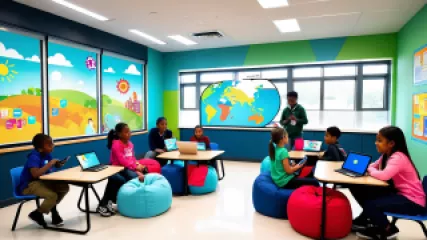Effective Online Interventions for Learning Disabilities
Learning disabilities can present significant challenges for individuals, affecting their ability to perform in academic, social, and professional settings. These disabilities encompass a range of disorders, including dyslexia, ADHD, and dyscalculia, among others. Fortunately, the rise of digital technology has paved the way for innovative online interventions that offer effective solutions for managing and overcoming these challenges.
This guide aims to provide an in-depth understanding of how to utilize online resources for learning disabilities intervention, offering step-by-step instructions and valuable insights into making the most of these tools.
Understanding Learning Disabilities
Before diving into the specifics of online interventions, it's crucial to understand what learning disabilities are. Learning disabilities are neurological disorders that affect one or more cognitive processes related to learning. They are not indicative of intelligence levels but are instead specific impairments in processing information.
Common Types of Learning Disabilities
- Dyslexia: Affects reading and related language-based processing skills.
- Dysgraphia: Impacts writing abilities, including handwriting, typing, and spelling.
- Dyscalculia: Influences mathematical skills and concepts.
- ADHD (Attention-Deficit/Hyperactivity Disorder): Affects attention, impulsivity, and hyperactivity.
- Nonverbal Learning Disabilities: Involves difficulties with nonverbal cues, such as body language and spatial awareness.
The Importance of Early Identification
Early identification of learning disabilities is critical for effective intervention. The sooner a child is diagnosed, the quicker they can receive the support they need to succeed. Recognizing the signs early on allows for timely implementation of strategies that can mitigate the impact of the disability.
Why Choose Online Interventions?
Online interventions offer several advantages over traditional methods. They provide flexibility, accessibility, and a wealth of resources that can be tailored to individual needs. Here are some compelling reasons to consider online therapy for learning disabilities:
Accessibility and Convenience
One of the most significant benefits of online interventions is accessibility. Individuals can access resources and support from anywhere, eliminating geographical barriers. This is particularly beneficial for those living in remote areas where specialized services may be limited.
Customized Learning Plans
Online platforms often offer personalized learning plans tailored to the specific needs of the user. These customized plans ensure that the interventions are relevant and effective, addressing the unique challenges faced by individuals with learning disabilities.
Engaging and Interactive Tools
Digital tools and resources can make learning more engaging and interactive. Many online interventions incorporate games, videos, and interactive exercises to keep users motivated and engaged, enhancing the overall learning experience.
Step-by-Step Guide to Implementing Online Interventions
Implementing online interventions for learning disabilities involves several steps. This section will provide a comprehensive guide to help you navigate the process effectively.
Step 1: Identify the Specific Learning Disability
The first step in implementing an online intervention is to identify the specific learning disability. A formal diagnosis from a qualified professional is essential. This diagnosis will inform the choice of interventions and ensure that they are appropriate for the individual's needs.
Consultation with Professionals
Seek consultation with educational psychologists, special education teachers, or other professionals experienced in diagnosing learning disabilities. They can conduct assessments and provide a detailed report outlining the nature and extent of the disability.
Self-Assessment Tools
There are also several online self-assessment tools available that can help identify potential learning disabilities. While these tools are not a substitute for professional diagnosis, they can provide valuable insights and indicate whether further evaluation is necessary.
Step 2: Research Available Online Resources
Once the specific learning disability has been identified, the next step is to research available online resources. There is a plethora of online platforms, apps, and websites dedicated to providing support for learning disabilities. Here are some key considerations:
Credibility and Expertise
Ensure that the resources you choose are credible and developed by experts in the field. Look for platforms with positive reviews and testimonials from users who have benefited from their services.
Range of Services
Consider the range of services offered by the platform. Effective interventions should include a variety of tools and resources, such as:
- Interactive exercises and activities
- Video tutorials and webinars
- Progress tracking and reporting
- Access to professional support and consultation
Cost and Accessibility
Evaluate the cost of the services and whether they fit within your budget. Many platforms offer free trials or freemium models, allowing you to explore their offerings before committing financially. Additionally, consider the accessibility of the platform—ensure it is user-friendly and accessible on multiple devices.
Step 3: Create a Personalized Intervention Plan
Creating a personalized intervention plan is crucial for the success of online interventions. This plan should outline specific goals, strategies, and timelines for addressing the learning disability.
Setting SMART Goals
Use the SMART (Specific, Measurable, Achievable, Relevant, Time-bound) framework to set clear and attainable goals. For example, if the individual has dyslexia, a SMART goal might be: "Improve reading comprehension by 20% within six months through daily practice and weekly progress assessments."
Choosing Appropriate Interventions
Select interventions that align with the identified goals. For instance, for dysgraphia, you might choose online writing exercises and typing practice tools. For ADHD, you could opt for apps that help with time management and organizational skills.
Regular Monitoring and Adjustment
Regularly monitor progress and adjust the intervention plan as needed. Use progress tracking tools provided by the online platform to assess improvement and make data-driven decisions. Be flexible and willing to modify the plan based on what works best for the individual.
Step 4: Engage and Motivate the Learner
Engagement and motivation are key factors in the success of online interventions. Here are some strategies to keep the learner motivated:
Incorporate Interests and Strengths
Integrate the learner's interests and strengths into the intervention plan. For example, if the individual enjoys music, use musical activities to enhance learning. Leveraging their strengths can boost confidence and motivation.
Gamification and Rewards
Many online platforms use gamification techniques to make learning fun and rewarding. Incorporate elements such as points, badges, and rewards to encourage consistent participation and effort.
Parental and Peer Support
Encourage parental involvement and seek peer support when possible. Involving parents in the intervention process can provide additional motivation and accountability. Peer support groups can also offer encouragement and a sense of community.
Step 5: Evaluate the Effectiveness of the Intervention
Evaluating the effectiveness of the intervention is essential to ensure that it is meeting the desired outcomes. Here are some methods to assess effectiveness:
Regular Progress Assessments
Conduct regular assessments to measure progress towards the set goals. Use tools such as quizzes, tests, and observational checklists to gather data on improvement.
Feedback from Learners and Parents
Gather feedback from the learners and their parents to understand their experiences and any challenges they may be facing. This feedback can provide valuable insights for refining the intervention plan.
Professional Reviews
Seek periodic reviews from professionals, such as educational psychologists or special education teachers. Their expertise can help identify areas for improvement and ensure that the intervention remains effective.
Case Study: A Successful Online Intervention
To illustrate the effectiveness of online interventions, let's explore a case study of a successful implementation:
Background
Mariam Gomez, a 12-year-old student, was diagnosed with dyslexia. She struggled with reading comprehension and often felt frustrated and demotivated in school. Her parents decided to seek online therapy for learning disabilities to provide her with the support she needed.
Intervention Plan
- Goals: Improve reading comprehension by 30% within six months.
- Tools: An online reading program with interactive exercises and progress tracking.
- Activities: Daily reading practice, weekly comprehension quizzes, and monthly progress reviews.
Implementation
Mariam's parents selected a reputable online platform that offered a comprehensive reading program designed for children with dyslexia. They created a personalized intervention plan with SMART goals and incorporated Mariam's interests in storytelling and creative writing.
Engagement Strategies
To keep Mariam engaged, the platform used gamification techniques, awarding points and badges for completing tasks. Mariam's parents also provided positive reinforcement and celebrated her achievements, no matter how small.
Results
After six months, Mariam's reading comprehension improved by 35%, surpassing the initial goal. Her confidence grew, and she became more enthusiastic about reading. The regular assessments and feedback from both Mariam and her parents played a crucial role in the success of the intervention.
Challenges and Solutions in Online Interventions
While online interventions offer numerous benefits, they also come with challenges. Understanding these challenges and finding effective solutions is essential for successful implementation.
Technical Difficulties
Technical issues such as internet connectivity problems, software glitches, and device compatibility can hinder the effectiveness of online interventions. To address these challenges:
- Ensure a reliable internet connection and have backup options available.
- Choose platforms with robust technical support and user-friendly interfaces.
- Regularly update software and devices to prevent compatibility issues.
Lack of Motivation and Engagement
Maintaining motivation and engagement can be challenging, especially for younger learners. Solutions include:
- Incorporate gamification techniques to make learning fun and rewarding.
- Set achievable goals and celebrate small milestones to boost confidence.
- Engage parents and peers to provide additional support and encouragement.
Limited Professional Guidance
While online platforms offer valuable resources, they may lack the personalized guidance of in-person interventions. To mitigate this:
- Supplement online resources with periodic consultations with professionals.
- Join online support groups and communities to connect with other learners and parents.
- Use platforms that offer access to professional support and guidance.
Conclusion: Embracing the Future of Learning Disabilities Interventions
The future of learning disabilities interventions is undoubtedly digital. Online therapy for learning disabilities, coaching for learning disabilities, and learning disabilities intervention online offer flexible, accessible, and effective solutions for individuals struggling with these challenges.
By understanding the nature of learning disabilities, selecting credible online resources, creating personalized intervention plans, and employing strategies to engage and motivate learners, we can empower individuals to overcome their challenges and achieve their full potential.
As we continue to embrace digital technology, the possibilities for innovative and impactful interventions are limitless. With the right tools and support, individuals with learning disabilities can thrive in every aspect of their lives.






